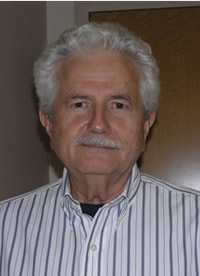 Robert S. Carney
Robert S. Carney
Position: Emeritus Professor, Department of Oceanography and Coastal Sciences
Phone: 225-578-6511
Fax: 225-578-6326
E-mail: rcarne1@lsu.edu
Office: 2211 Energy, Coast and Environment Building
Bachelor's Degree(s): B.S. Duke University, 1967
Master's Degrees(s): M.S. Texas A&M University, 1971
Ph.D.(s): Ph.D. Oregon State University, 1977
Research Interests
Biological oceanography, research administration
Courses Taught
OCS 4550. Biological Oceanography
OCS 1006. HONORS: Introduction to Oceanography
Selected Publications
MacAvoy, S.E., R.S. Carney, E. Morgan, and S.A. Macko. 2008. Stable isotope variation among the mussel Bathymodiolus childressi and associated heterotrophic fauna at four cold-seep communities in the Gulf of Mexico. Journal of Shellfish Research 27(1):147-151.
MacAvoy, S.E., E. Morgan, R.S. Carney, and S.A. Macko. 2008. Chemoautolithotrophic production as a fuel for heterotrophs in hydrocarbon seeps: an examination of mobile benthic fauna and seep residents. Journal of Shellfish Research 27 (1):153-161.
Cordes, E.E., S.L. Carney, S. Hourdez, R.S. Carney, J. M. Brooks, and C.R. Fisher. 2007. Cold seeps of the deep Gulf of Mexico: community structure and biogeographic comparisons to Atlantic equatorial belt seep communities. Deep- Sea Research I 54:637-653.
Dattagupta, S., J. Martin, S. Liao, R.S. Carney, and C.R. Fisher. 2007. Deep-seahydrocarbon seep gastropod Bathynerita naticoidea responds to cues from the habitat-providing mussel Bathymodiolus childressi. Marine Ecology 28:193-198.
Gilhooly, W.P., R.S. Carney, and S.A. Macko. 2007. Relationships between sulfide oxidizing bacterial mats and their carbon sources in northern Gulf of Mexico coldseeps. Organic Geochemistry 38:380-393.
Carney, R.S. 2005. Zonation of deep-sea biota on continental margins. Oceanography and Marine Biology: An annual review 43:211-279.
MacAvoy, S.E., C.R. Fisher, R.S. Carney, and S.A. Macko. 2005. Nutritional associations among fauna at hydrocarbon seep communities in the Gulf of Mexico. Marine Ecology Progress Series 292:51-60.
Sassen, R., H.H. Roberts, R. Carney, A.V. Milkov, D.A. DeFritas, B. Lanoil, and C.L. Zhang. 2004. Free hydrocarbon gas, gas hydrate, and authigenic minerals in chemosynthetic communities of the northern Gulf of Mexico continental slope: relation to microbial processes. Chemical Geology 205:195-217.
Bergquist, D.C., T. Ward, E.E. Cordes, T. McNelis, R. Kosoff, S. Hourdez, R. Carney,and C.R. Fisher. 2003. Community structure of vestimentiferan-generated habitat islands from upper Louisiana slope cold seeps. Journal Experimental Marine Biology Ecology 289:197-222.
MacAvoy, S.E., S.A. Macko, and R.S. Carney. 2003. Links between chemosynthetic production and mobile predators on the Louisiana continental slope: stable carbon isotopes of specific fatty acids. Chemical Geology 201:229-239.
MacAvoy, S., R. Carney, S. Macko, and C. Fisher. 2002. Use of chemosyntheticbiomass by large mobile, benthic predators in the Gulf of Mexico. Marine Ecology Progress Series 225:65-78.